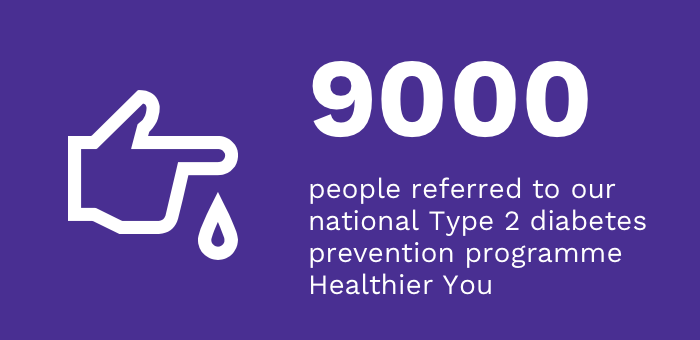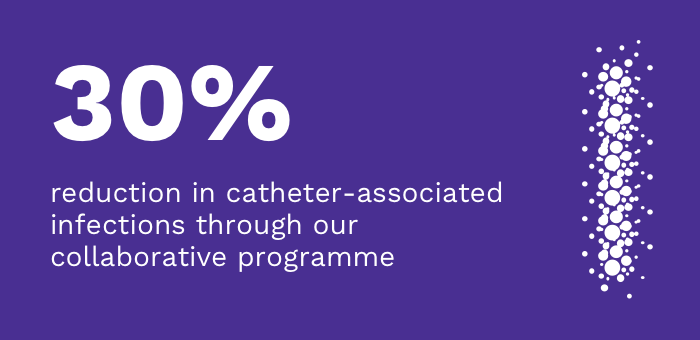Annual Review 2017/18

Chairman
Prof Richard Barker OBE

Chief Executive
Tara Donnelly
Speeding up the best in health and care in south London
Welcome to our 2017/18 digital Annual Review. Explore this report to see examples of the work we’ve done across our three core health and care goals: improve lives, save money and drive economic growth.
We believe that innovation is vital to securing the future of the NHS. As innovation leaders, we see many promising signs of entrepreneurship in the NHS, despite all the challenges faced by the service. In the first five years of operation, working closely with our members we have been able to spread a wide range of innovations and thousands of patients have received better care as a result.
We also know that spreading innovation is complex work and that, both locally and nationally, barriers to rapid spread remain. Barriers can relate to pressures on clinicians’ time, funding and resource, commissioning arrangements, leadership challenges and conservative attitudes. At the Health Innovation Network, our mission is to speed up the best in health and care and we do this by helping organisations in south London to break through these barriers, and to adopt innovations that improve lives and save money.
In 2017/18, our team approached this challenge with professionalism, expertise, collaboration and good humour. In this report, we detail just some of the ways our team helped organisations in south London spread innovation. We’ve also included a range of voices – from our staff, from NHS staff and from the local population we serve.
Throughout the year, we worked across our key clinical priorities – Diabetes, MSK, Healthy Ageing (including dementia), Stroke Prevention and AF and Patient Safety. Examples of our work across these areas include:
Supporting people with chronic pain
Our award-winning ESCAPE-pain rehabilitation service has rapidly expanded to provide exercise programmes that help those suffering chronic joint pain. Currently in 11 local sites, it has also expanded to 60 across the UK throughout the year and is spreading fast, improving thousands of lives and saving millions of pounds as it does so.
Improving hospital transfers and reducing length of stay
Working with care homes and hospitals we have supported the spread of Sutton Vanguard’s Hospital Transfer Pathway, affectionately known as the ‘Red Bag’ scheme. This is a simple innovation which ensures records and personal belongings are kept in one identifiable place to follow a care home resident on their journey to and from hospital. The scheme’s Red Bags improve communication between care homes and hospitals, paramedics and clinicians, and have been demonstrated to both improve outcomes and reduce hospital length of stay. In the past year, we estimate that south London residents have benefited from the Red Bag scheme on 2,000 occasions.
Spotting the signs of sepsis
Our short film Spotting the Signs of Sepsis has been viewed more than 2.8 million times and was shortlisted for the 2018 HSJ Patient Safety Awards. One mother got in touch to tell us that she felt that the video had given her the information she needed to recognise sepsis and then save her daughter’s life.
Detecting irregular heart rhythms with new tech
Mobile ECGs for south London: we launched a major drive to reduce strokes related to Atrial Fibrillation, spreading 350 digitally-enabled ECG devices to staff to increase detection rates and prevent up to 924 strokes in south London alone.
Our work to cultivate a vibrant ecosystem for the digital companies of the future and speed up the use of digital solutions with strong evidence has had an impact. In 2017/18, we completed the first full year of the DigitalHealth.London Accelerator programme, which we host on behalf of the whole of London. The companies’ assessment of impact was that our programme doubled the speed of their progress across the NHS in London.
We worked with a wide range of partners throughout the year, including a new partnership with the Office for Life Sciences in the implementation of the Accelerated Access Review, in addition to forging ever stronger local links with health and care organisations in south London.
Above all, our work was driven by our members’ priorities, reflected in the Sustainability & Transformation Plans (STPs). Despite the progress made, our members continue to struggle with tight funding settlements, a fragmented system and an urgent need to ensure we can sustainably care for our local population as it ages and as long term conditions continue to rise. We believe innovation, transformation and sustainability go hand in hand, and will continue to work hard to support our members with these challenges.
With NHS England’s recent confirmation of a new five-year licence for AHSNs, we now have an opportunity to not only build on the past year, but to learn from the first five-year licence. Zoe Lelliott, our deputy chief executive, reflects on our first five years of our AHSN licence here. In the next five years we have committed to working ever more closely with the other 14 AHSNs in the AHSN Network, sharing our solutions with them and adopting their best innovations in south London.
Looking ahead, we will increase our focus on improving health (years of happy and healthy life) and reducing health inequalities across south London, using evidence-based and innovative approaches as well as our clinical networks and digital strengths.
When we spread innovation, we do it with three goals in mind: improving lives, saving money and creating the right conditions for economic growth. We’ve structured this report in line with those goals and reported on just some of our achievements in these areas. We hope it inspires you to join us in our efforts to use innovation to transform the NHS.

















